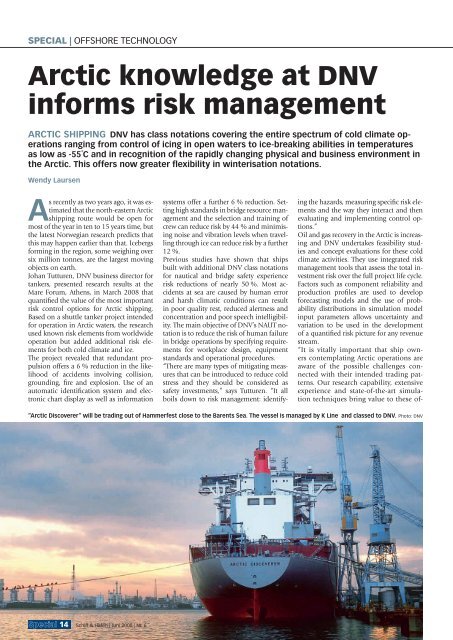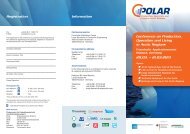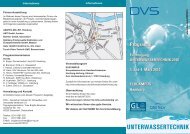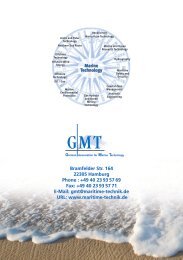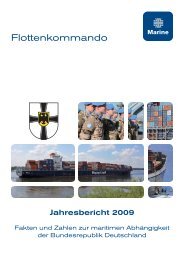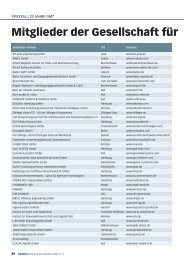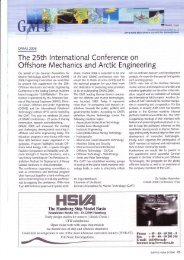Offshore Technology
Offshore Technology
Offshore Technology
You also want an ePaper? Increase the reach of your titles
YUMPU automatically turns print PDFs into web optimized ePapers that Google loves.
SPECIAL | OFFSHORE TECHNOLOGY<br />
Arctic knowledge at DNV<br />
informs risk management<br />
ARCTIC SHIPPING DNV has class notations covering the entire spectrum of cold climate operations<br />
ranging from control of icing in open waters to ice-breaking abilities in temperatures<br />
as low as -55˚C and in recognition of the rapidly changing physical and business environment in<br />
the Arctic. This offers now greater fl exibility in winterisation notations.<br />
Wendy Laursen<br />
As recently as two years ago, it was estimated<br />
that the north-eastern Arctic<br />
shipping route would be open for<br />
most of the year in ten to 15 years time, but<br />
the latest Norwegian research predicts that<br />
this may happen earlier than that. Icebergs<br />
forming in the region, some weighing over<br />
six million tonnes, are the largest moving<br />
objects on earth.<br />
Johan Tutturen, DNV business director for<br />
tankers, presented research results at the<br />
Mare Forum, Athens, in March 2008 that<br />
quantifi ed the value of the most important<br />
risk control options for Arctic shipping.<br />
Based on a shuttle tanker project intended<br />
for operation in Arctic waters, the research<br />
used known risk elements from worldwide<br />
operation but added additional risk elements<br />
for both cold climate and ice.<br />
The project revealed that redundant propulsion<br />
offers a 6 % reduction in the likelihood<br />
of accidents involving collision,<br />
grounding, fi re and explosion. Use of an<br />
automatic identifi cation system and electronic<br />
chart display as well as information<br />
systems offer a further 6 % reduction. Setting<br />
high standards in bridge resource management<br />
and the selection and trai ning of<br />
crew can reduce risk by 44 % and minimising<br />
noise and vibration levels when travelling<br />
through ice can reduce risk by a further<br />
12 %.<br />
Previous studies have shown that ships<br />
built with additional DNV class notations<br />
for nautical and bridge safety experience<br />
risk reductions of nearly 50 %. Most accidents<br />
at sea are caused by human error<br />
and harsh climatic conditions can result<br />
in poor quality rest, reduced alertness and<br />
concentration and poor speech intelligibility.<br />
The main objective of DNV’s NAUT notation<br />
is to reduce the risk of human failure<br />
in bridge operations by specifying requirements<br />
for workplace design, equipment<br />
standards and operational procedures.<br />
“There are many types of mitigating measures<br />
that can be introduced to reduce cold<br />
stress and they should be considered as<br />
safety investments,” says Tutturen. “It all<br />
boils down to risk management: identify-<br />
ing the hazards, measuring specifi c risk elements<br />
and the way they interact and then<br />
evaluating and implementing control options.”<br />
Oil and gas recovery in the Arctic is increasing<br />
and DNV undertakes feasibility studies<br />
and concept evaluations for these cold<br />
climate activities. They use integrated risk<br />
management tools that assess the total investment<br />
risk over the full project life cycle.<br />
Factors such as component reliability and<br />
production profi les are used to develop<br />
forecasting models and the use of probability<br />
distributions in simulation model<br />
input parameters allows uncertainty and<br />
variation to be used in the development<br />
of a quantifi ed risk picture for any revenue<br />
stream.<br />
“It is vitally important that ship owners<br />
contemplating Arctic operations are<br />
aware of the possible challenges connected<br />
with their intended trading patterns.<br />
Our research capability, extensive<br />
experience and state-of-the-art simulation<br />
techniques bring value to these of-<br />
“Arctic Discoverer“ will be trading out of Hammerfest close to the Barents Sea. The vessel is managed by K Line and classed to DNV. Photo: DNV<br />
Special 14 Schiff & Hafen | Juni 2008 | Nr. 6


